Unemployment in Australia: Causes, Effects and Government Policies
VerifiedAdded on 2023/06/04
|13
|3304
|69
AI Summary
This article discusses the issue of unemployment in Australia, its causes, effects, and government policies to reduce it. It covers the definition of unemployment, the current unemployment rate, and the challenges faced by the unemployed. The article also explores demand-side and supply-side policies used by the government to tackle unemployment.
Contribute Materials
Your contribution can guide someone’s learning journey. Share your
documents today.
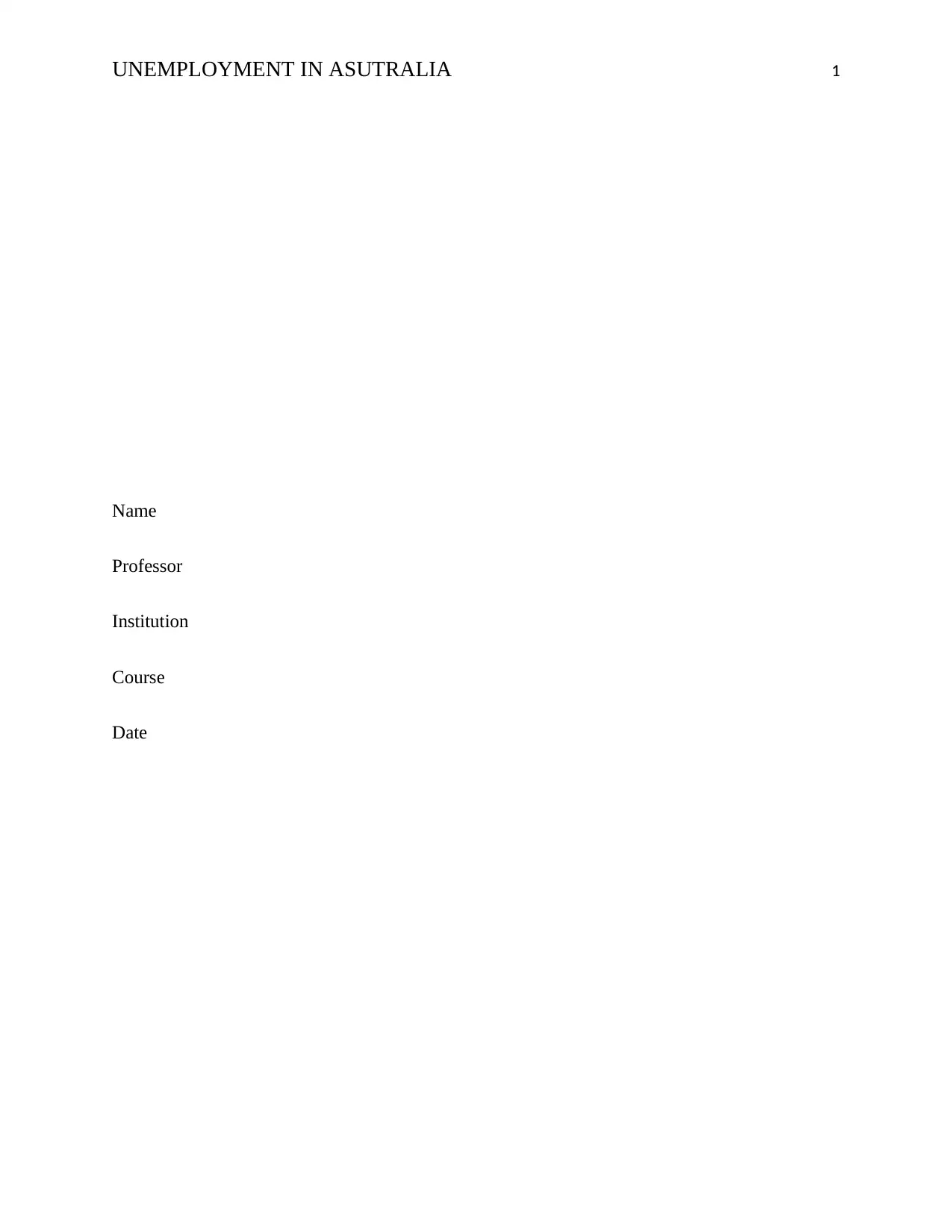
UNEMPLOYMENT IN ASUTRALIA 1
Name
Professor
Institution
Course
Date
Name
Professor
Institution
Course
Date
Secure Best Marks with AI Grader
Need help grading? Try our AI Grader for instant feedback on your assignments.
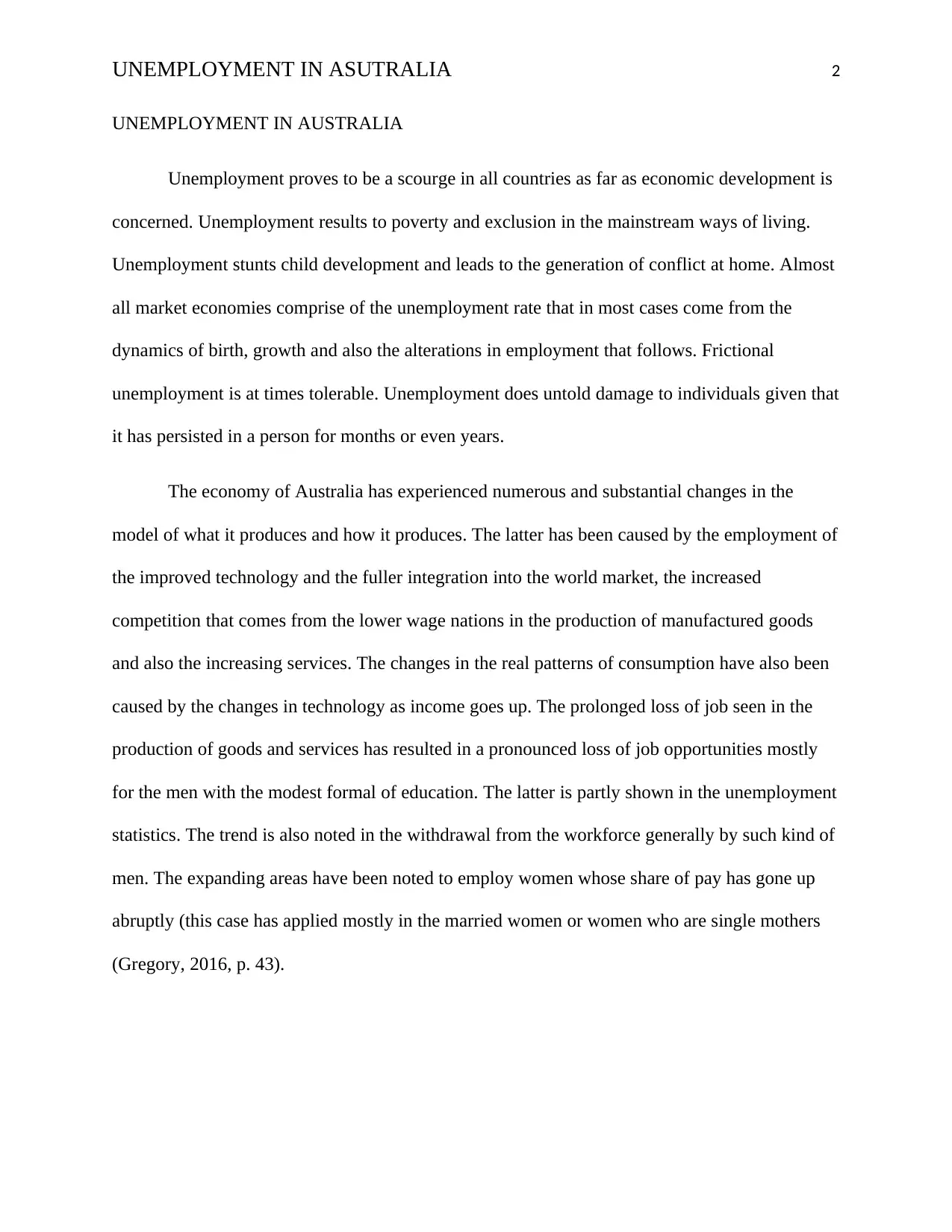
UNEMPLOYMENT IN ASUTRALIA 2
UNEMPLOYMENT IN AUSTRALIA
Unemployment proves to be a scourge in all countries as far as economic development is
concerned. Unemployment results to poverty and exclusion in the mainstream ways of living.
Unemployment stunts child development and leads to the generation of conflict at home. Almost
all market economies comprise of the unemployment rate that in most cases come from the
dynamics of birth, growth and also the alterations in employment that follows. Frictional
unemployment is at times tolerable. Unemployment does untold damage to individuals given that
it has persisted in a person for months or even years.
The economy of Australia has experienced numerous and substantial changes in the
model of what it produces and how it produces. The latter has been caused by the employment of
the improved technology and the fuller integration into the world market, the increased
competition that comes from the lower wage nations in the production of manufactured goods
and also the increasing services. The changes in the real patterns of consumption have also been
caused by the changes in technology as income goes up. The prolonged loss of job seen in the
production of goods and services has resulted in a pronounced loss of job opportunities mostly
for the men with the modest formal of education. The latter is partly shown in the unemployment
statistics. The trend is also noted in the withdrawal from the workforce generally by such kind of
men. The expanding areas have been noted to employ women whose share of pay has gone up
abruptly (this case has applied mostly in the married women or women who are single mothers
(Gregory, 2016, p. 43).
UNEMPLOYMENT IN AUSTRALIA
Unemployment proves to be a scourge in all countries as far as economic development is
concerned. Unemployment results to poverty and exclusion in the mainstream ways of living.
Unemployment stunts child development and leads to the generation of conflict at home. Almost
all market economies comprise of the unemployment rate that in most cases come from the
dynamics of birth, growth and also the alterations in employment that follows. Frictional
unemployment is at times tolerable. Unemployment does untold damage to individuals given that
it has persisted in a person for months or even years.
The economy of Australia has experienced numerous and substantial changes in the
model of what it produces and how it produces. The latter has been caused by the employment of
the improved technology and the fuller integration into the world market, the increased
competition that comes from the lower wage nations in the production of manufactured goods
and also the increasing services. The changes in the real patterns of consumption have also been
caused by the changes in technology as income goes up. The prolonged loss of job seen in the
production of goods and services has resulted in a pronounced loss of job opportunities mostly
for the men with the modest formal of education. The latter is partly shown in the unemployment
statistics. The trend is also noted in the withdrawal from the workforce generally by such kind of
men. The expanding areas have been noted to employ women whose share of pay has gone up
abruptly (this case has applied mostly in the married women or women who are single mothers
(Gregory, 2016, p. 43).
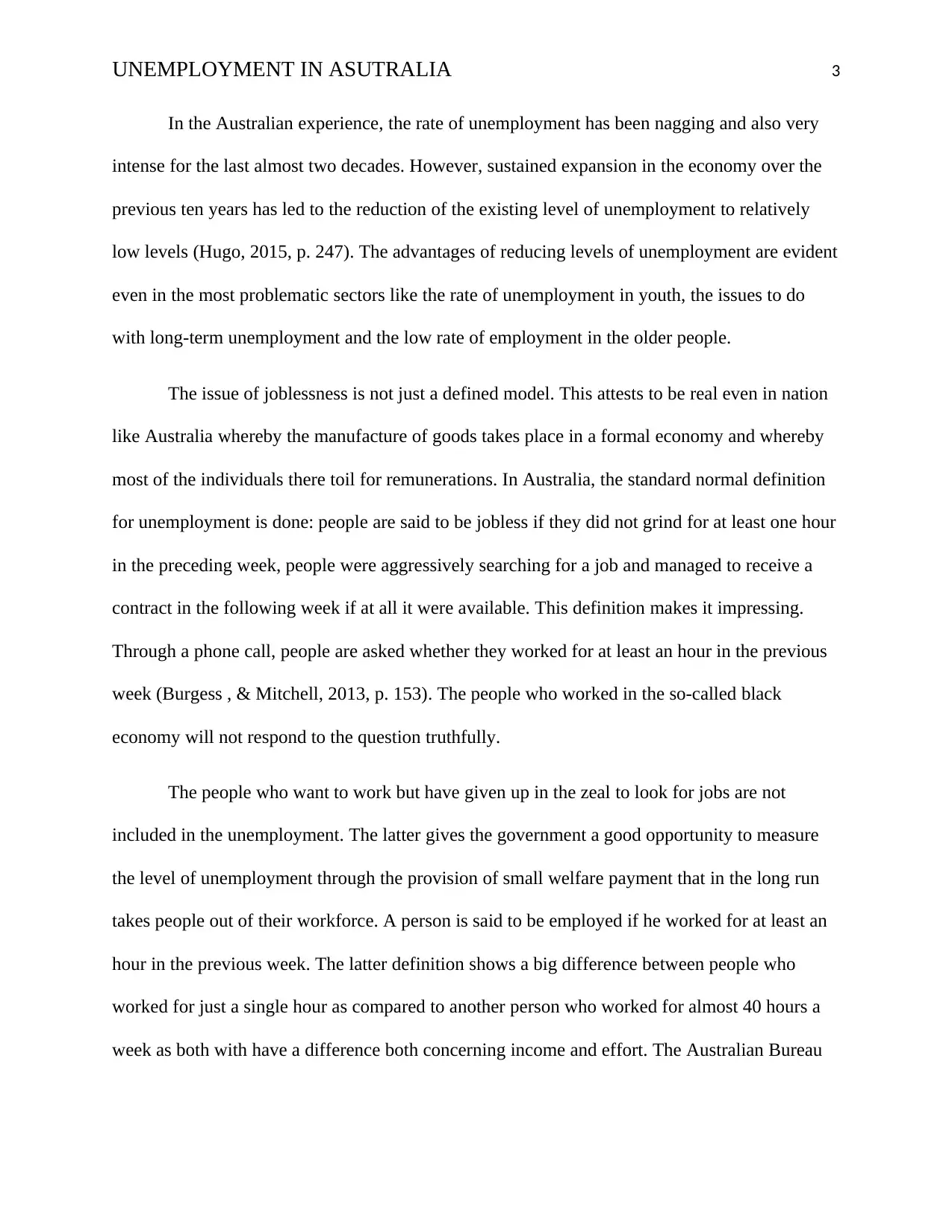
UNEMPLOYMENT IN ASUTRALIA 3
In the Australian experience, the rate of unemployment has been nagging and also very
intense for the last almost two decades. However, sustained expansion in the economy over the
previous ten years has led to the reduction of the existing level of unemployment to relatively
low levels (Hugo, 2015, p. 247). The advantages of reducing levels of unemployment are evident
even in the most problematic sectors like the rate of unemployment in youth, the issues to do
with long-term unemployment and the low rate of employment in the older people.
The issue of joblessness is not just a defined model. This attests to be real even in nation
like Australia whereby the manufacture of goods takes place in a formal economy and whereby
most of the individuals there toil for remunerations. In Australia, the standard normal definition
for unemployment is done: people are said to be jobless if they did not grind for at least one hour
in the preceding week, people were aggressively searching for a job and managed to receive a
contract in the following week if at all it were available. This definition makes it impressing.
Through a phone call, people are asked whether they worked for at least an hour in the previous
week (Burgess , & Mitchell, 2013, p. 153). The people who worked in the so-called black
economy will not respond to the question truthfully.
The people who want to work but have given up in the zeal to look for jobs are not
included in the unemployment. The latter gives the government a good opportunity to measure
the level of unemployment through the provision of small welfare payment that in the long run
takes people out of their workforce. A person is said to be employed if he worked for at least an
hour in the previous week. The latter definition shows a big difference between people who
worked for just a single hour as compared to another person who worked for almost 40 hours a
week as both with have a difference both concerning income and effort. The Australian Bureau
In the Australian experience, the rate of unemployment has been nagging and also very
intense for the last almost two decades. However, sustained expansion in the economy over the
previous ten years has led to the reduction of the existing level of unemployment to relatively
low levels (Hugo, 2015, p. 247). The advantages of reducing levels of unemployment are evident
even in the most problematic sectors like the rate of unemployment in youth, the issues to do
with long-term unemployment and the low rate of employment in the older people.
The issue of joblessness is not just a defined model. This attests to be real even in nation
like Australia whereby the manufacture of goods takes place in a formal economy and whereby
most of the individuals there toil for remunerations. In Australia, the standard normal definition
for unemployment is done: people are said to be jobless if they did not grind for at least one hour
in the preceding week, people were aggressively searching for a job and managed to receive a
contract in the following week if at all it were available. This definition makes it impressing.
Through a phone call, people are asked whether they worked for at least an hour in the previous
week (Burgess , & Mitchell, 2013, p. 153). The people who worked in the so-called black
economy will not respond to the question truthfully.
The people who want to work but have given up in the zeal to look for jobs are not
included in the unemployment. The latter gives the government a good opportunity to measure
the level of unemployment through the provision of small welfare payment that in the long run
takes people out of their workforce. A person is said to be employed if he worked for at least an
hour in the previous week. The latter definition shows a big difference between people who
worked for just a single hour as compared to another person who worked for almost 40 hours a
week as both with have a difference both concerning income and effort. The Australian Bureau
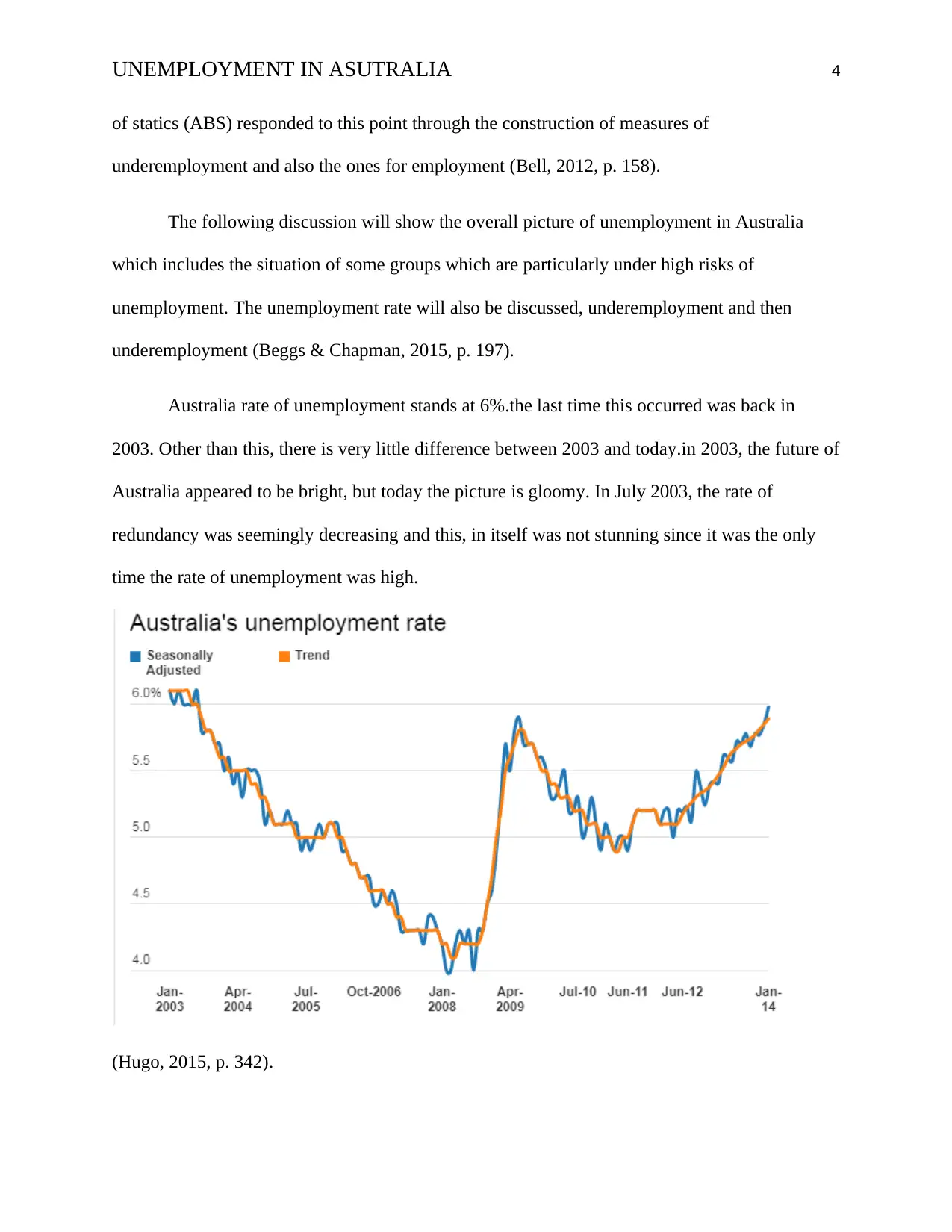
UNEMPLOYMENT IN ASUTRALIA 4
of statics (ABS) responded to this point through the construction of measures of
underemployment and also the ones for employment (Bell, 2012, p. 158).
The following discussion will show the overall picture of unemployment in Australia
which includes the situation of some groups which are particularly under high risks of
unemployment. The unemployment rate will also be discussed, underemployment and then
underemployment (Beggs & Chapman, 2015, p. 197).
Australia rate of unemployment stands at 6%.the last time this occurred was back in
2003. Other than this, there is very little difference between 2003 and today.in 2003, the future of
Australia appeared to be bright, but today the picture is gloomy. In July 2003, the rate of
redundancy was seemingly decreasing and this, in itself was not stunning since it was the only
time the rate of unemployment was high.
(Hugo, 2015, p. 342).
of statics (ABS) responded to this point through the construction of measures of
underemployment and also the ones for employment (Bell, 2012, p. 158).
The following discussion will show the overall picture of unemployment in Australia
which includes the situation of some groups which are particularly under high risks of
unemployment. The unemployment rate will also be discussed, underemployment and then
underemployment (Beggs & Chapman, 2015, p. 197).
Australia rate of unemployment stands at 6%.the last time this occurred was back in
2003. Other than this, there is very little difference between 2003 and today.in 2003, the future of
Australia appeared to be bright, but today the picture is gloomy. In July 2003, the rate of
redundancy was seemingly decreasing and this, in itself was not stunning since it was the only
time the rate of unemployment was high.
(Hugo, 2015, p. 342).
Secure Best Marks with AI Grader
Need help grading? Try our AI Grader for instant feedback on your assignments.
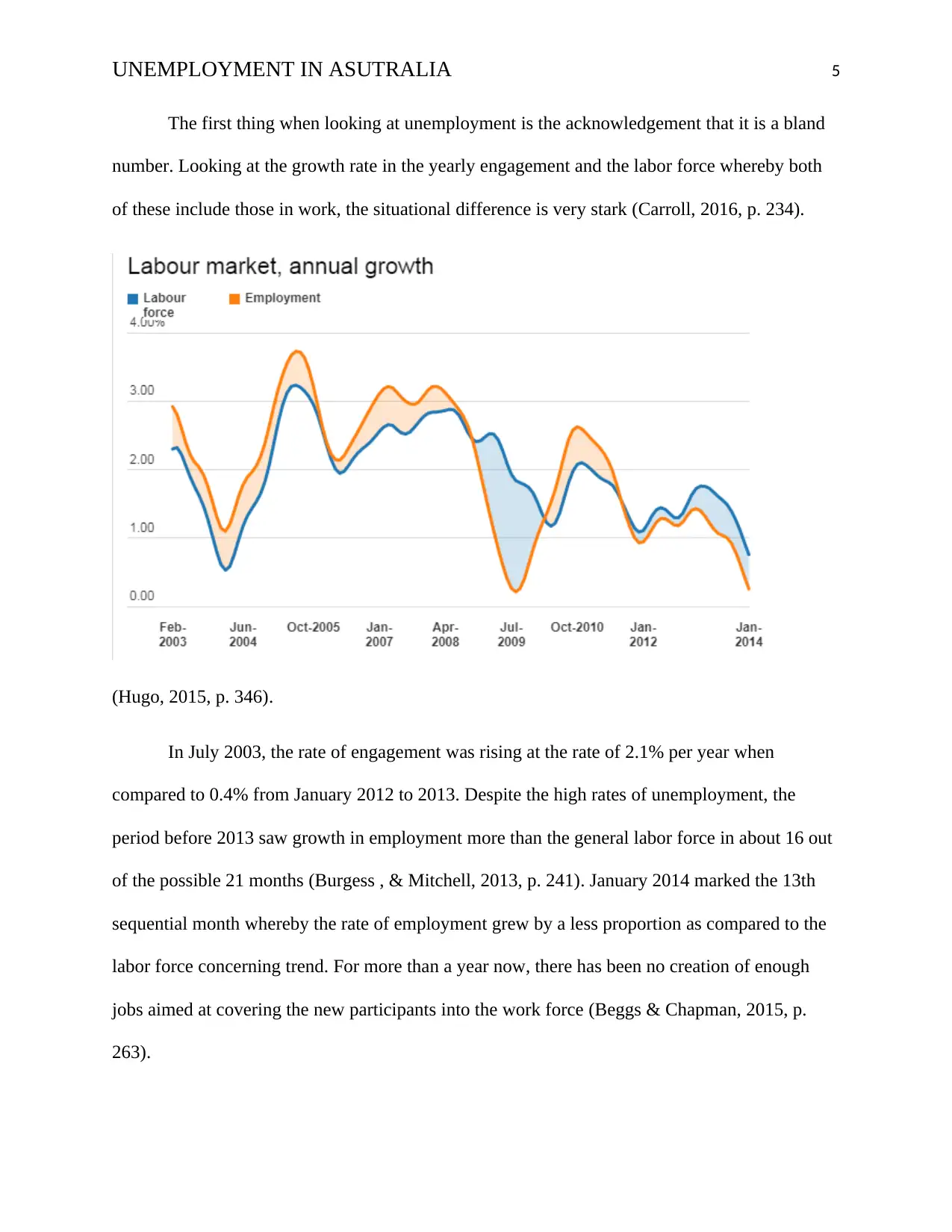
UNEMPLOYMENT IN ASUTRALIA 5
The first thing when looking at unemployment is the acknowledgement that it is a bland
number. Looking at the growth rate in the yearly engagement and the labor force whereby both
of these include those in work, the situational difference is very stark (Carroll, 2016, p. 234).
(Hugo, 2015, p. 346).
In July 2003, the rate of engagement was rising at the rate of 2.1% per year when
compared to 0.4% from January 2012 to 2013. Despite the high rates of unemployment, the
period before 2013 saw growth in employment more than the general labor force in about 16 out
of the possible 21 months (Burgess , & Mitchell, 2013, p. 241). January 2014 marked the 13th
sequential month whereby the rate of employment grew by a less proportion as compared to the
labor force concerning trend. For more than a year now, there has been no creation of enough
jobs aimed at covering the new participants into the work force (Beggs & Chapman, 2015, p.
263).
The first thing when looking at unemployment is the acknowledgement that it is a bland
number. Looking at the growth rate in the yearly engagement and the labor force whereby both
of these include those in work, the situational difference is very stark (Carroll, 2016, p. 234).
(Hugo, 2015, p. 346).
In July 2003, the rate of engagement was rising at the rate of 2.1% per year when
compared to 0.4% from January 2012 to 2013. Despite the high rates of unemployment, the
period before 2013 saw growth in employment more than the general labor force in about 16 out
of the possible 21 months (Burgess , & Mitchell, 2013, p. 241). January 2014 marked the 13th
sequential month whereby the rate of employment grew by a less proportion as compared to the
labor force concerning trend. For more than a year now, there has been no creation of enough
jobs aimed at covering the new participants into the work force (Beggs & Chapman, 2015, p.
263).
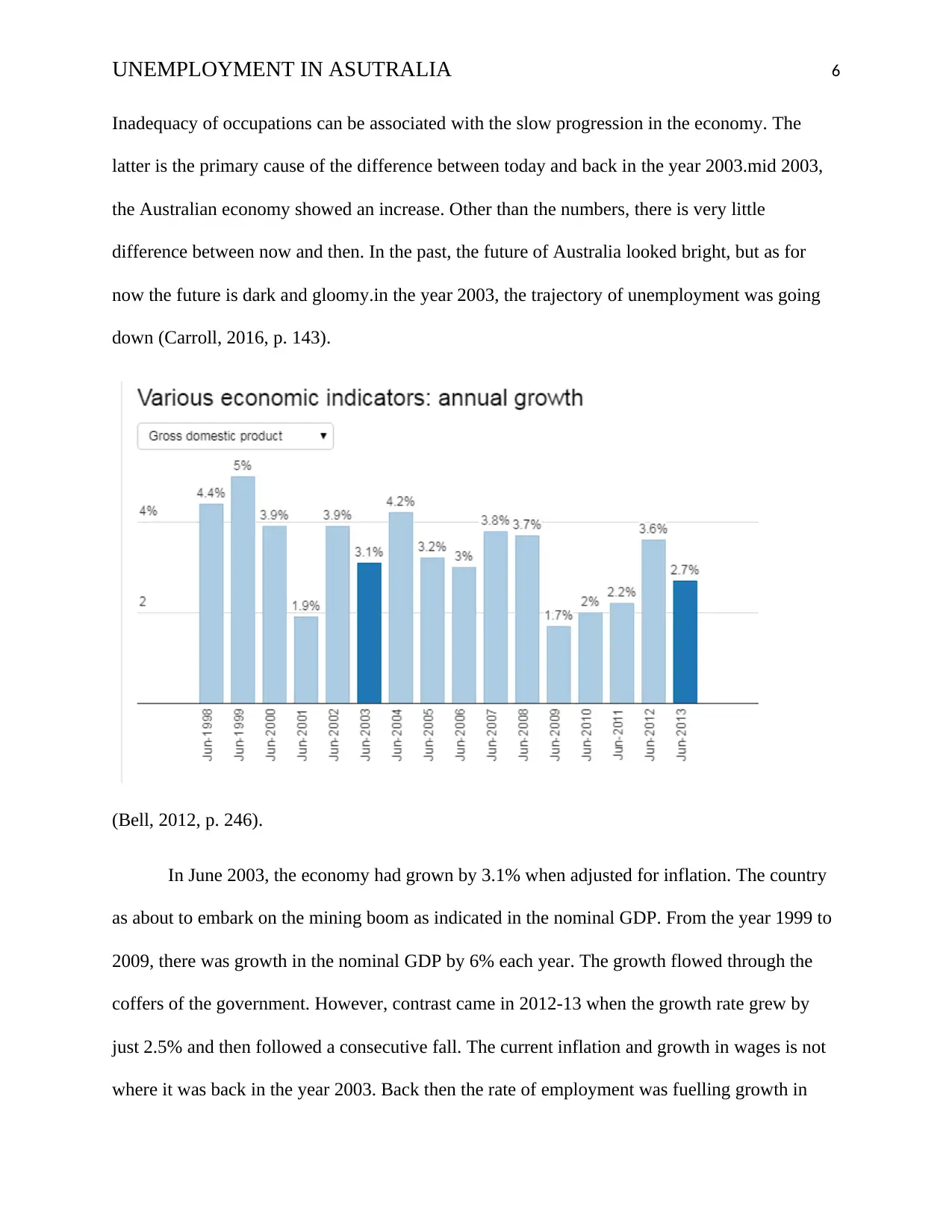
UNEMPLOYMENT IN ASUTRALIA 6
Inadequacy of occupations can be associated with the slow progression in the economy. The
latter is the primary cause of the difference between today and back in the year 2003.mid 2003,
the Australian economy showed an increase. Other than the numbers, there is very little
difference between now and then. In the past, the future of Australia looked bright, but as for
now the future is dark and gloomy.in the year 2003, the trajectory of unemployment was going
down (Carroll, 2016, p. 143).
(Bell, 2012, p. 246).
In June 2003, the economy had grown by 3.1% when adjusted for inflation. The country
as about to embark on the mining boom as indicated in the nominal GDP. From the year 1999 to
2009, there was growth in the nominal GDP by 6% each year. The growth flowed through the
coffers of the government. However, contrast came in 2012-13 when the growth rate grew by
just 2.5% and then followed a consecutive fall. The current inflation and growth in wages is not
where it was back in the year 2003. Back then the rate of employment was fuelling growth in
Inadequacy of occupations can be associated with the slow progression in the economy. The
latter is the primary cause of the difference between today and back in the year 2003.mid 2003,
the Australian economy showed an increase. Other than the numbers, there is very little
difference between now and then. In the past, the future of Australia looked bright, but as for
now the future is dark and gloomy.in the year 2003, the trajectory of unemployment was going
down (Carroll, 2016, p. 143).
(Bell, 2012, p. 246).
In June 2003, the economy had grown by 3.1% when adjusted for inflation. The country
as about to embark on the mining boom as indicated in the nominal GDP. From the year 1999 to
2009, there was growth in the nominal GDP by 6% each year. The growth flowed through the
coffers of the government. However, contrast came in 2012-13 when the growth rate grew by
just 2.5% and then followed a consecutive fall. The current inflation and growth in wages is not
where it was back in the year 2003. Back then the rate of employment was fuelling growth in
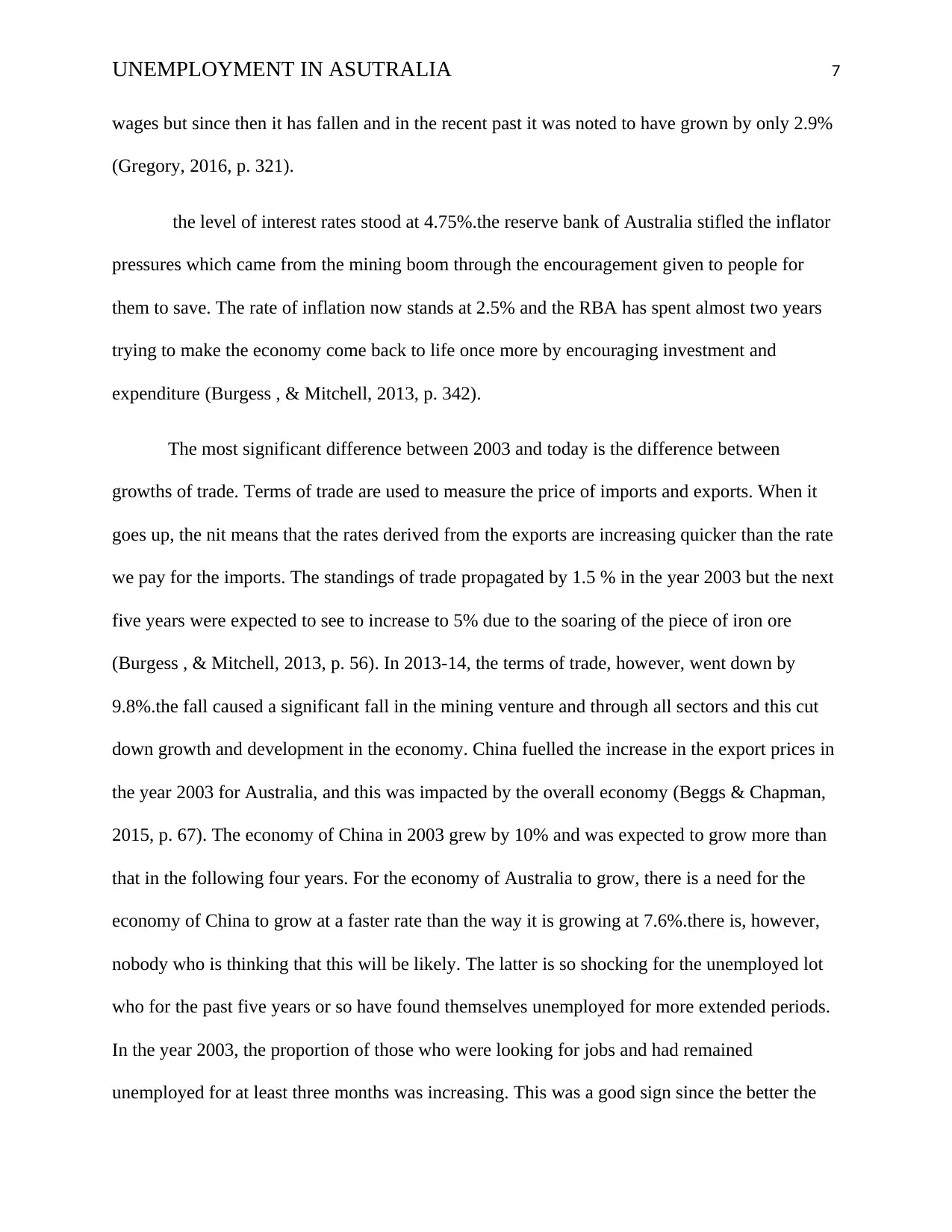
UNEMPLOYMENT IN ASUTRALIA 7
wages but since then it has fallen and in the recent past it was noted to have grown by only 2.9%
(Gregory, 2016, p. 321).
the level of interest rates stood at 4.75%.the reserve bank of Australia stifled the inflator
pressures which came from the mining boom through the encouragement given to people for
them to save. The rate of inflation now stands at 2.5% and the RBA has spent almost two years
trying to make the economy come back to life once more by encouraging investment and
expenditure (Burgess , & Mitchell, 2013, p. 342).
The most significant difference between 2003 and today is the difference between
growths of trade. Terms of trade are used to measure the price of imports and exports. When it
goes up, the nit means that the rates derived from the exports are increasing quicker than the rate
we pay for the imports. The standings of trade propagated by 1.5 % in the year 2003 but the next
five years were expected to see to increase to 5% due to the soaring of the piece of iron ore
(Burgess , & Mitchell, 2013, p. 56). In 2013-14, the terms of trade, however, went down by
9.8%.the fall caused a significant fall in the mining venture and through all sectors and this cut
down growth and development in the economy. China fuelled the increase in the export prices in
the year 2003 for Australia, and this was impacted by the overall economy (Beggs & Chapman,
2015, p. 67). The economy of China in 2003 grew by 10% and was expected to grow more than
that in the following four years. For the economy of Australia to grow, there is a need for the
economy of China to grow at a faster rate than the way it is growing at 7.6%.there is, however,
nobody who is thinking that this will be likely. The latter is so shocking for the unemployed lot
who for the past five years or so have found themselves unemployed for more extended periods.
In the year 2003, the proportion of those who were looking for jobs and had remained
unemployed for at least three months was increasing. This was a good sign since the better the
wages but since then it has fallen and in the recent past it was noted to have grown by only 2.9%
(Gregory, 2016, p. 321).
the level of interest rates stood at 4.75%.the reserve bank of Australia stifled the inflator
pressures which came from the mining boom through the encouragement given to people for
them to save. The rate of inflation now stands at 2.5% and the RBA has spent almost two years
trying to make the economy come back to life once more by encouraging investment and
expenditure (Burgess , & Mitchell, 2013, p. 342).
The most significant difference between 2003 and today is the difference between
growths of trade. Terms of trade are used to measure the price of imports and exports. When it
goes up, the nit means that the rates derived from the exports are increasing quicker than the rate
we pay for the imports. The standings of trade propagated by 1.5 % in the year 2003 but the next
five years were expected to see to increase to 5% due to the soaring of the piece of iron ore
(Burgess , & Mitchell, 2013, p. 56). In 2013-14, the terms of trade, however, went down by
9.8%.the fall caused a significant fall in the mining venture and through all sectors and this cut
down growth and development in the economy. China fuelled the increase in the export prices in
the year 2003 for Australia, and this was impacted by the overall economy (Beggs & Chapman,
2015, p. 67). The economy of China in 2003 grew by 10% and was expected to grow more than
that in the following four years. For the economy of Australia to grow, there is a need for the
economy of China to grow at a faster rate than the way it is growing at 7.6%.there is, however,
nobody who is thinking that this will be likely. The latter is so shocking for the unemployed lot
who for the past five years or so have found themselves unemployed for more extended periods.
In the year 2003, the proportion of those who were looking for jobs and had remained
unemployed for at least three months was increasing. This was a good sign since the better the
Paraphrase This Document
Need a fresh take? Get an instant paraphrase of this document with our AI Paraphraser
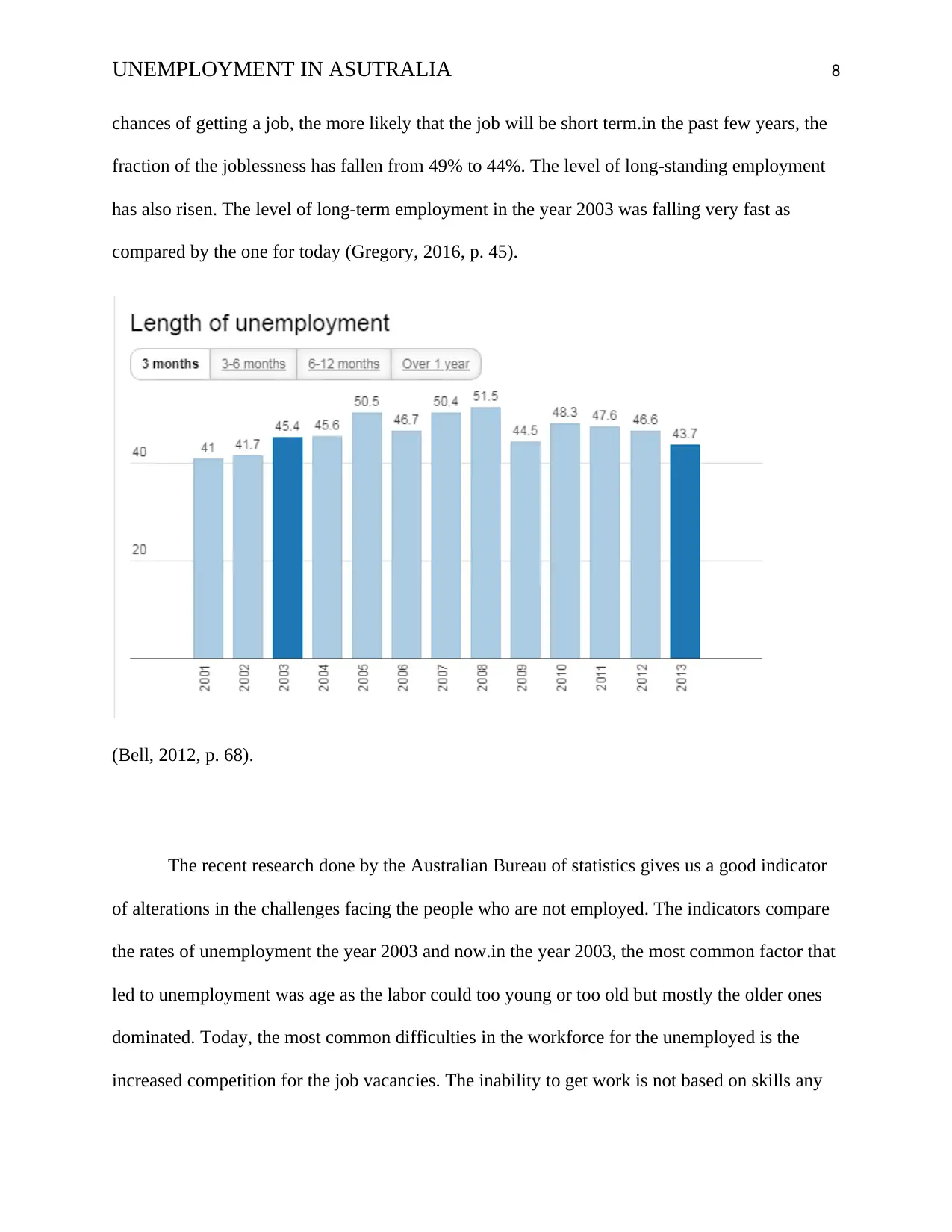
UNEMPLOYMENT IN ASUTRALIA 8
chances of getting a job, the more likely that the job will be short term.in the past few years, the
fraction of the joblessness has fallen from 49% to 44%. The level of long-standing employment
has also risen. The level of long-term employment in the year 2003 was falling very fast as
compared by the one for today (Gregory, 2016, p. 45).
(Bell, 2012, p. 68).
The recent research done by the Australian Bureau of statistics gives us a good indicator
of alterations in the challenges facing the people who are not employed. The indicators compare
the rates of unemployment the year 2003 and now.in the year 2003, the most common factor that
led to unemployment was age as the labor could too young or too old but mostly the older ones
dominated. Today, the most common difficulties in the workforce for the unemployed is the
increased competition for the job vacancies. The inability to get work is not based on skills any
chances of getting a job, the more likely that the job will be short term.in the past few years, the
fraction of the joblessness has fallen from 49% to 44%. The level of long-standing employment
has also risen. The level of long-term employment in the year 2003 was falling very fast as
compared by the one for today (Gregory, 2016, p. 45).
(Bell, 2012, p. 68).
The recent research done by the Australian Bureau of statistics gives us a good indicator
of alterations in the challenges facing the people who are not employed. The indicators compare
the rates of unemployment the year 2003 and now.in the year 2003, the most common factor that
led to unemployment was age as the labor could too young or too old but mostly the older ones
dominated. Today, the most common difficulties in the workforce for the unemployed is the
increased competition for the job vacancies. The inability to get work is not based on skills any
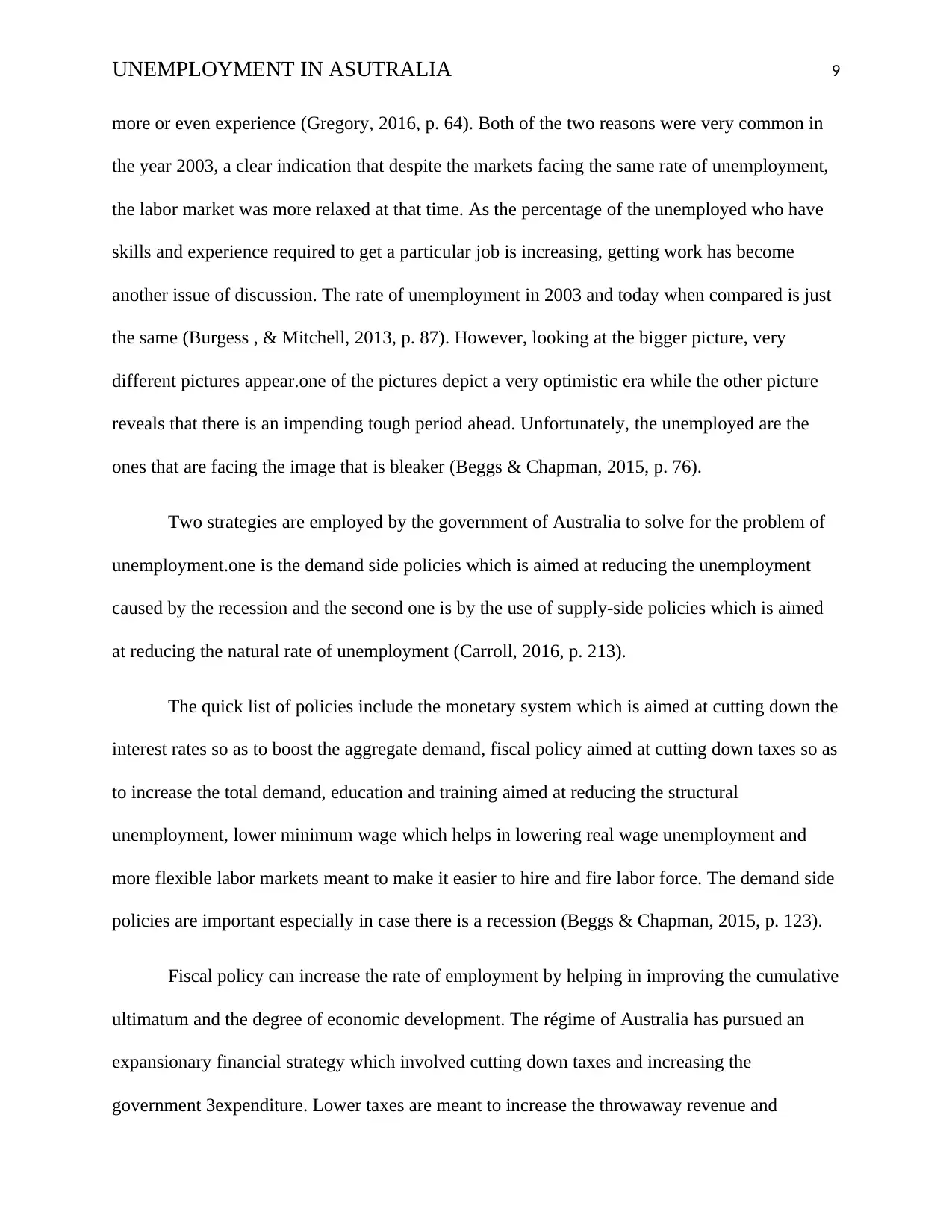
UNEMPLOYMENT IN ASUTRALIA 9
more or even experience (Gregory, 2016, p. 64). Both of the two reasons were very common in
the year 2003, a clear indication that despite the markets facing the same rate of unemployment,
the labor market was more relaxed at that time. As the percentage of the unemployed who have
skills and experience required to get a particular job is increasing, getting work has become
another issue of discussion. The rate of unemployment in 2003 and today when compared is just
the same (Burgess , & Mitchell, 2013, p. 87). However, looking at the bigger picture, very
different pictures appear.one of the pictures depict a very optimistic era while the other picture
reveals that there is an impending tough period ahead. Unfortunately, the unemployed are the
ones that are facing the image that is bleaker (Beggs & Chapman, 2015, p. 76).
Two strategies are employed by the government of Australia to solve for the problem of
unemployment.one is the demand side policies which is aimed at reducing the unemployment
caused by the recession and the second one is by the use of supply-side policies which is aimed
at reducing the natural rate of unemployment (Carroll, 2016, p. 213).
The quick list of policies include the monetary system which is aimed at cutting down the
interest rates so as to boost the aggregate demand, fiscal policy aimed at cutting down taxes so as
to increase the total demand, education and training aimed at reducing the structural
unemployment, lower minimum wage which helps in lowering real wage unemployment and
more flexible labor markets meant to make it easier to hire and fire labor force. The demand side
policies are important especially in case there is a recession (Beggs & Chapman, 2015, p. 123).
Fiscal policy can increase the rate of employment by helping in improving the cumulative
ultimatum and the degree of economic development. The régime of Australia has pursued an
expansionary financial strategy which involved cutting down taxes and increasing the
government 3expenditure. Lower taxes are meant to increase the throwaway revenue and
more or even experience (Gregory, 2016, p. 64). Both of the two reasons were very common in
the year 2003, a clear indication that despite the markets facing the same rate of unemployment,
the labor market was more relaxed at that time. As the percentage of the unemployed who have
skills and experience required to get a particular job is increasing, getting work has become
another issue of discussion. The rate of unemployment in 2003 and today when compared is just
the same (Burgess , & Mitchell, 2013, p. 87). However, looking at the bigger picture, very
different pictures appear.one of the pictures depict a very optimistic era while the other picture
reveals that there is an impending tough period ahead. Unfortunately, the unemployed are the
ones that are facing the image that is bleaker (Beggs & Chapman, 2015, p. 76).
Two strategies are employed by the government of Australia to solve for the problem of
unemployment.one is the demand side policies which is aimed at reducing the unemployment
caused by the recession and the second one is by the use of supply-side policies which is aimed
at reducing the natural rate of unemployment (Carroll, 2016, p. 213).
The quick list of policies include the monetary system which is aimed at cutting down the
interest rates so as to boost the aggregate demand, fiscal policy aimed at cutting down taxes so as
to increase the total demand, education and training aimed at reducing the structural
unemployment, lower minimum wage which helps in lowering real wage unemployment and
more flexible labor markets meant to make it easier to hire and fire labor force. The demand side
policies are important especially in case there is a recession (Beggs & Chapman, 2015, p. 123).
Fiscal policy can increase the rate of employment by helping in improving the cumulative
ultimatum and the degree of economic development. The régime of Australia has pursued an
expansionary financial strategy which involved cutting down taxes and increasing the
government 3expenditure. Lower taxes are meant to increase the throwaway revenue and
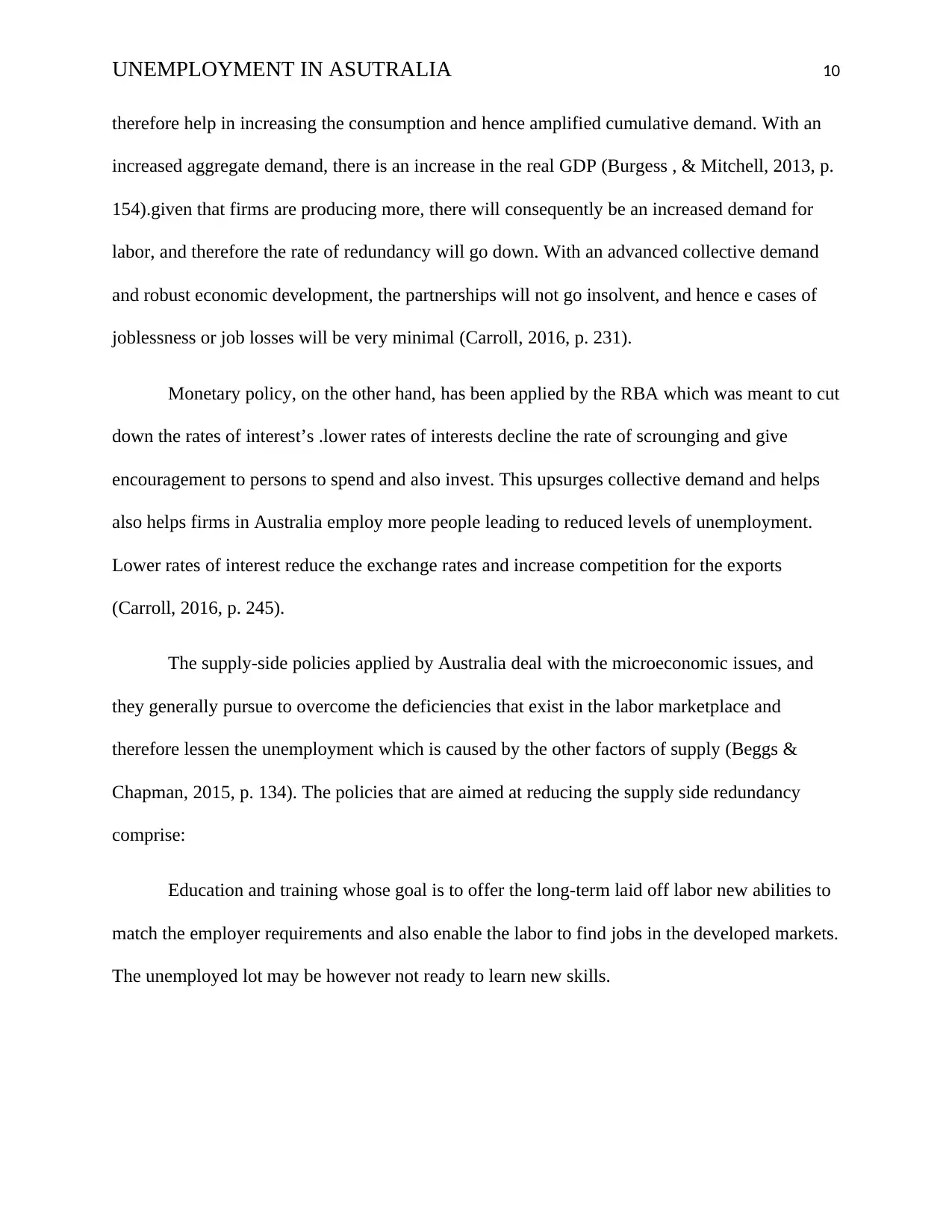
UNEMPLOYMENT IN ASUTRALIA 10
therefore help in increasing the consumption and hence amplified cumulative demand. With an
increased aggregate demand, there is an increase in the real GDP (Burgess , & Mitchell, 2013, p.
154).given that firms are producing more, there will consequently be an increased demand for
labor, and therefore the rate of redundancy will go down. With an advanced collective demand
and robust economic development, the partnerships will not go insolvent, and hence e cases of
joblessness or job losses will be very minimal (Carroll, 2016, p. 231).
Monetary policy, on the other hand, has been applied by the RBA which was meant to cut
down the rates of interest’s .lower rates of interests decline the rate of scrounging and give
encouragement to persons to spend and also invest. This upsurges collective demand and helps
also helps firms in Australia employ more people leading to reduced levels of unemployment.
Lower rates of interest reduce the exchange rates and increase competition for the exports
(Carroll, 2016, p. 245).
The supply-side policies applied by Australia deal with the microeconomic issues, and
they generally pursue to overcome the deficiencies that exist in the labor marketplace and
therefore lessen the unemployment which is caused by the other factors of supply (Beggs &
Chapman, 2015, p. 134). The policies that are aimed at reducing the supply side redundancy
comprise:
Education and training whose goal is to offer the long-term laid off labor new abilities to
match the employer requirements and also enable the labor to find jobs in the developed markets.
The unemployed lot may be however not ready to learn new skills.
therefore help in increasing the consumption and hence amplified cumulative demand. With an
increased aggregate demand, there is an increase in the real GDP (Burgess , & Mitchell, 2013, p.
154).given that firms are producing more, there will consequently be an increased demand for
labor, and therefore the rate of redundancy will go down. With an advanced collective demand
and robust economic development, the partnerships will not go insolvent, and hence e cases of
joblessness or job losses will be very minimal (Carroll, 2016, p. 231).
Monetary policy, on the other hand, has been applied by the RBA which was meant to cut
down the rates of interest’s .lower rates of interests decline the rate of scrounging and give
encouragement to persons to spend and also invest. This upsurges collective demand and helps
also helps firms in Australia employ more people leading to reduced levels of unemployment.
Lower rates of interest reduce the exchange rates and increase competition for the exports
(Carroll, 2016, p. 245).
The supply-side policies applied by Australia deal with the microeconomic issues, and
they generally pursue to overcome the deficiencies that exist in the labor marketplace and
therefore lessen the unemployment which is caused by the other factors of supply (Beggs &
Chapman, 2015, p. 134). The policies that are aimed at reducing the supply side redundancy
comprise:
Education and training whose goal is to offer the long-term laid off labor new abilities to
match the employer requirements and also enable the labor to find jobs in the developed markets.
The unemployed lot may be however not ready to learn new skills.
Secure Best Marks with AI Grader
Need help grading? Try our AI Grader for instant feedback on your assignments.
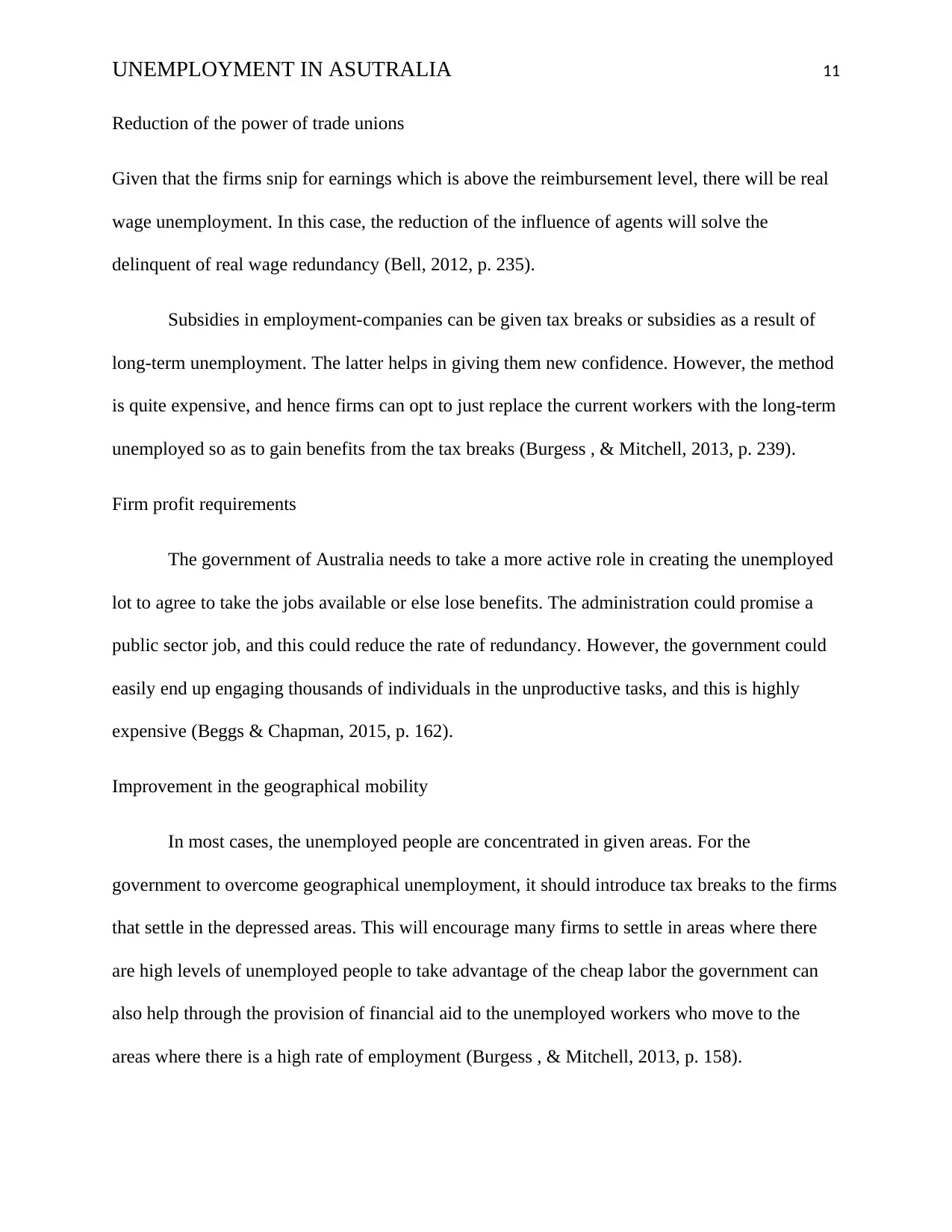
UNEMPLOYMENT IN ASUTRALIA 11
Reduction of the power of trade unions
Given that the firms snip for earnings which is above the reimbursement level, there will be real
wage unemployment. In this case, the reduction of the influence of agents will solve the
delinquent of real wage redundancy (Bell, 2012, p. 235).
Subsidies in employment-companies can be given tax breaks or subsidies as a result of
long-term unemployment. The latter helps in giving them new confidence. However, the method
is quite expensive, and hence firms can opt to just replace the current workers with the long-term
unemployed so as to gain benefits from the tax breaks (Burgess , & Mitchell, 2013, p. 239).
Firm profit requirements
The government of Australia needs to take a more active role in creating the unemployed
lot to agree to take the jobs available or else lose benefits. The administration could promise a
public sector job, and this could reduce the rate of redundancy. However, the government could
easily end up engaging thousands of individuals in the unproductive tasks, and this is highly
expensive (Beggs & Chapman, 2015, p. 162).
Improvement in the geographical mobility
In most cases, the unemployed people are concentrated in given areas. For the
government to overcome geographical unemployment, it should introduce tax breaks to the firms
that settle in the depressed areas. This will encourage many firms to settle in areas where there
are high levels of unemployed people to take advantage of the cheap labor the government can
also help through the provision of financial aid to the unemployed workers who move to the
areas where there is a high rate of employment (Burgess , & Mitchell, 2013, p. 158).
Reduction of the power of trade unions
Given that the firms snip for earnings which is above the reimbursement level, there will be real
wage unemployment. In this case, the reduction of the influence of agents will solve the
delinquent of real wage redundancy (Bell, 2012, p. 235).
Subsidies in employment-companies can be given tax breaks or subsidies as a result of
long-term unemployment. The latter helps in giving them new confidence. However, the method
is quite expensive, and hence firms can opt to just replace the current workers with the long-term
unemployed so as to gain benefits from the tax breaks (Burgess , & Mitchell, 2013, p. 239).
Firm profit requirements
The government of Australia needs to take a more active role in creating the unemployed
lot to agree to take the jobs available or else lose benefits. The administration could promise a
public sector job, and this could reduce the rate of redundancy. However, the government could
easily end up engaging thousands of individuals in the unproductive tasks, and this is highly
expensive (Beggs & Chapman, 2015, p. 162).
Improvement in the geographical mobility
In most cases, the unemployed people are concentrated in given areas. For the
government to overcome geographical unemployment, it should introduce tax breaks to the firms
that settle in the depressed areas. This will encourage many firms to settle in areas where there
are high levels of unemployed people to take advantage of the cheap labor the government can
also help through the provision of financial aid to the unemployed workers who move to the
areas where there is a high rate of employment (Burgess , & Mitchell, 2013, p. 158).
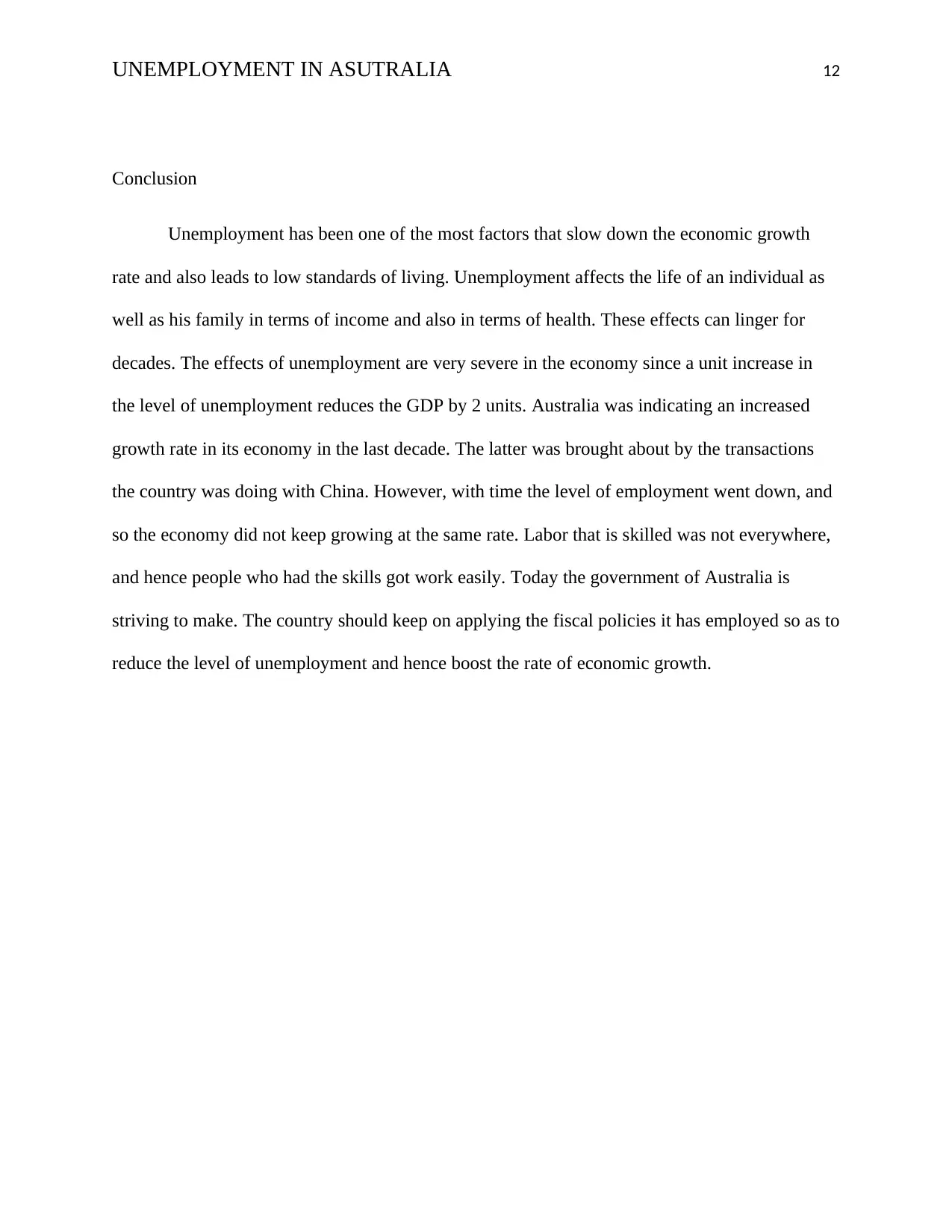
UNEMPLOYMENT IN ASUTRALIA 12
Conclusion
Unemployment has been one of the most factors that slow down the economic growth
rate and also leads to low standards of living. Unemployment affects the life of an individual as
well as his family in terms of income and also in terms of health. These effects can linger for
decades. The effects of unemployment are very severe in the economy since a unit increase in
the level of unemployment reduces the GDP by 2 units. Australia was indicating an increased
growth rate in its economy in the last decade. The latter was brought about by the transactions
the country was doing with China. However, with time the level of employment went down, and
so the economy did not keep growing at the same rate. Labor that is skilled was not everywhere,
and hence people who had the skills got work easily. Today the government of Australia is
striving to make. The country should keep on applying the fiscal policies it has employed so as to
reduce the level of unemployment and hence boost the rate of economic growth.
Conclusion
Unemployment has been one of the most factors that slow down the economic growth
rate and also leads to low standards of living. Unemployment affects the life of an individual as
well as his family in terms of income and also in terms of health. These effects can linger for
decades. The effects of unemployment are very severe in the economy since a unit increase in
the level of unemployment reduces the GDP by 2 units. Australia was indicating an increased
growth rate in its economy in the last decade. The latter was brought about by the transactions
the country was doing with China. However, with time the level of employment went down, and
so the economy did not keep growing at the same rate. Labor that is skilled was not everywhere,
and hence people who had the skills got work easily. Today the government of Australia is
striving to make. The country should keep on applying the fiscal policies it has employed so as to
reduce the level of unemployment and hence boost the rate of economic growth.
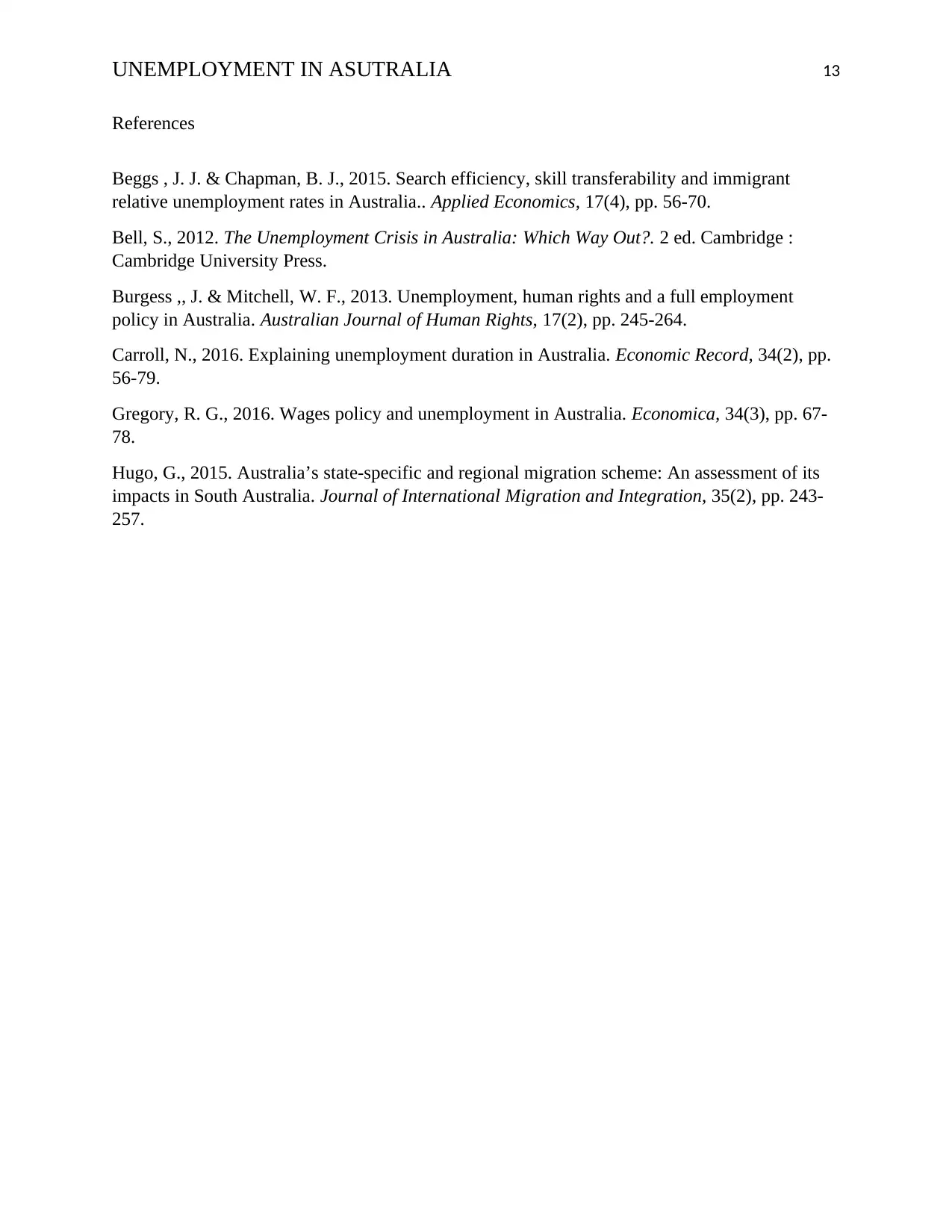
UNEMPLOYMENT IN ASUTRALIA 13
References
Beggs , J. J. & Chapman, B. J., 2015. Search efficiency, skill transferability and immigrant
relative unemployment rates in Australia.. Applied Economics, 17(4), pp. 56-70.
Bell, S., 2012. The Unemployment Crisis in Australia: Which Way Out?. 2 ed. Cambridge :
Cambridge University Press.
Burgess ,, J. & Mitchell, W. F., 2013. Unemployment, human rights and a full employment
policy in Australia. Australian Journal of Human Rights, 17(2), pp. 245-264.
Carroll, N., 2016. Explaining unemployment duration in Australia. Economic Record, 34(2), pp.
56-79.
Gregory, R. G., 2016. Wages policy and unemployment in Australia. Economica, 34(3), pp. 67-
78.
Hugo, G., 2015. Australia’s state-specific and regional migration scheme: An assessment of its
impacts in South Australia. Journal of International Migration and Integration, 35(2), pp. 243-
257.
References
Beggs , J. J. & Chapman, B. J., 2015. Search efficiency, skill transferability and immigrant
relative unemployment rates in Australia.. Applied Economics, 17(4), pp. 56-70.
Bell, S., 2012. The Unemployment Crisis in Australia: Which Way Out?. 2 ed. Cambridge :
Cambridge University Press.
Burgess ,, J. & Mitchell, W. F., 2013. Unemployment, human rights and a full employment
policy in Australia. Australian Journal of Human Rights, 17(2), pp. 245-264.
Carroll, N., 2016. Explaining unemployment duration in Australia. Economic Record, 34(2), pp.
56-79.
Gregory, R. G., 2016. Wages policy and unemployment in Australia. Economica, 34(3), pp. 67-
78.
Hugo, G., 2015. Australia’s state-specific and regional migration scheme: An assessment of its
impacts in South Australia. Journal of International Migration and Integration, 35(2), pp. 243-
257.
1 out of 13
Related Documents
Your All-in-One AI-Powered Toolkit for Academic Success.
+13062052269
info@desklib.com
Available 24*7 on WhatsApp / Email
![[object Object]](/_next/static/media/star-bottom.7253800d.svg)
Unlock your academic potential
© 2024 | Zucol Services PVT LTD | All rights reserved.





